2022 |
||
| 9. | 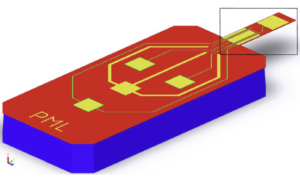 | N. F. S. de Bem; M. G. Ruppert; A. J. Fleming; Y. K. Yong In: Sensors and Actuators A: Physical, vol. 338, pp. 113496, 2022, ISSN: 0924-4247, (This work was supported by the Australian Research Council Discovery Project DP170101813). Abstract | Links | BibTeX | Tags: AFM, DP170101813 @article{J22a,The use of integrated on-chip actuation simplifies the identification of a cantilever resonance, can improve imaging speed, and enables the use of smaller cantilevers, which is required for low-force imaging at high speed. This article describes a cantilever with on-chip actuation and novel dual-sensing capabilities for AFM. The dual-sensing configuration allows for tip displacement and tip force to be measured simultaneously. A mathematical model is developed and validated with finite element analysis. A physical prototype is presented, and its calibration and validation are presented. The cantilever is optimized for use in off-resonance tapping modes. Experimental results demonstrate an agreement between the on-chip sensors and external force and displacement measurements. |
| 8. | 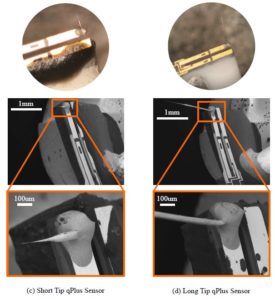 | M. G. Ruppert; D. Martin-Jimenez; Y. K. Yong; A. Ihle; A. Schirmeisen; A. J. Fleming; D. Ebeling Experimental Analysis of Tip Vibrations at Higher Eigenmodes of QPlus Sensors for Atomic Force Microscopy Journal Article In: Nanotechnology, vol. 33, iss. 18, pp. 185503, 2022, ISSN: 1361-6528, (This work was supported in part by the Australian Research Council Discovery Project DP170101813). Abstract | Links | BibTeX | Tags: Actuator, AFM, Cantilever, DP170101813, Multifrequency AFM, piezoelectric @article{Ruppert2022,QPlus sensors are non-contact atomic force microscope probes constructed from a quartz tuning fork and a tungsten wire with an electrochemically etched tip. These probes are self-sensing and offer an atomic-scale spatial resolution. Therefore, qPlus sensors are routinely used to visualize the chemical structure of adsorbed organic molecules via the so-called bond imaging technique. This is achieved by functionalizing the AFM tip with a single CO molecule and exciting the sensor at the first vertical cantilever resonance mode. Recent work using higher-order resonance modes has also resolved the chemical structure of single organic molecules. However, in these experiments, the image contrast can differ significantly from the conventional bond imaging contrast, which was suspected to be caused by unknown vibrations of the tip. This work investigates the source of these artefacts by using a combination of mechanical simulation and laser vibrometry to characterize a range of sensors with different tip wire geometries. The results show that increased tip mass and length cause increased torsional rotation of the tuning fork beam due to the off-center mounting of the tip wire, and increased flexural vibration of the tip. These undesirable motions cause lateral deflection of the probe tip as it approaches the sample, which is rationalized to be the cause of the different image contrast. The results also provide a guide for future probe development to reduce these issues. |
2021 |
||
| 7. |  | M. G. Ruppert; N. F. S. de Bem; A. J. Fleming; Y. K. Yong Characterization of Active Microcantilevers Using Laser Doppler Vibrometry Book Chapter In: Vibration Engineering for a Sustainable Future , Chapter 45, Springer, 2021, ISBN: 978-3-030-48153-7, (This work was supported by the Australian Research Council Discovery Project DP170101813). Abstract | Links | BibTeX | Tags: AFM, Cantilever, DP170101813, MEMS, Piezoelectric Transducers and Drives, Smart Structures @inbook{Ruppert2021b,Active atomic force microscope cantilevers with on-chip actuation and sensing provide several advantages over passive cantilevers which rely on piezoacoustic base-excitation and the optical beam deflection measurement. Most importantly, these cantilevers provide clean frequency responses, the possibility of down-scaling and parallelization to cantilever arrays as well as the absence of optical interferences. In this paper, we demonstrate the analysis and calibration steps for three active cantilever geometries with integrated piezoelectric actuation. For this purpose, laser Doppler vibrometry (LDV) is used to experimentally obtain the deflection mode shapes of the first three eigenmodes, calibrate actuation gains, and to determine the dynamic modal stiffnesses using the Brownian spectrum of the cantilever. The experimental values are compared with finite element simulations. |
| 6. | 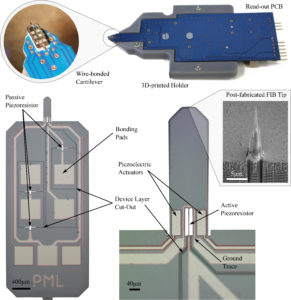 | M. G. Ruppert; A. J. Fleming; Y. K. Yong Active atomic force microscope cantilevers with integrated device layer piezoresistive sensors Journal Article In: Sensors & Actuators: A. Physical, vol. 319, pp. 112519, 2021, ISSN: 0924-4247, (This work was supported by the Australian Research Council Discovery Project DP170101813). Abstract | Links | BibTeX | Tags: AFM, Cantilever, DP170101813, MEMS, Sensors, Smart Structures @article{Ruppert2021,Active atomic force microscope cantilevers with on-chip actuation and sensing provide several advantages over passive cantilevers which rely on piezoacoustic base-excitation and optical beam deflection measurement. Active microcantilevers exhibit a clean frequency response, provide a path-way to miniturization and parallelization and avoid the need for optical alignment. However, active microcantilevers are presently limited by the feedthrough between actuators and sensors, and by the cost associated with custom microfabrication. In this work, we propose a hybrid cantilever design with integrated piezoelectric actuators and a piezoresistive sensor fabricated from the silicon device layer without requiring an additional doping step. As a result, the design can be fabricated using a commercial five-mask microelectromechanical systems fabrication process. The theoretical piezoresistor sensitivity is compared with finite element simulations and experimental results obtained from a prototype device. The proposed approach is demonstrated to be a promising alternative to conventional microcantilever actuation and deflection sensing |
2020 |
||
| 5. | 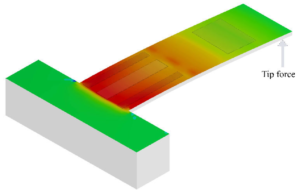 | N. F. S. de Bem; M. G. Ruppert; Y. K. Yong; A. J. Fleming Integrated force and displacement sensing in active microcantilevers for off-resonance tapping mode atomic force microscopy Proceedings Article In: International Conference on Manipulation, Automation and Robotics at Small Scales (MARSS), pp. 1-6, 2020, (This work was supported by the Australian Research Council Discovery Project DP170101813). Abstract | Links | BibTeX | Tags: AFM, DP170101813, MEMS, SPM @inproceedings{C20c,Integrated on-chip actuation and sensing in microcantilevers for atomic force microscopy (AFM) allows faster scanning speeds, cleaner frequency responses and smaller cantilevers. However, a single integrated sensor suffers from crosscoupling between displacements originating from tip-sample forces and direct actuation. This paper addresses this issue by presenting a novel microcantilever with on-chip actuation and integrated dual sensing for AFM with application to offresonance tapping modes in AFM. The proposed system is able to measure tip force and deflection simultaneously. A mathematical model is developed for a rectangular cantilever to describe the system and is validated with finite element analysis. |
| 4. | 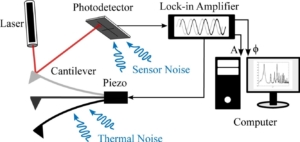 | M. G. Ruppert; N. J. Bartlett; Y. K. Yong; A. J. Fleming Amplitude Noise Spectrum of a Lock-in Amplifier: Application to Microcantilever Noise Measurements Journal Article In: Sensors and Actuators A: Physical, vol. 312, pp. 112092, 2020, (This work was supported by the Australian Research Council Discovery Project DP170101813). Abstract | Links | BibTeX | Tags: AFM, Cantilever, Demodulation, DP170101813, MEMS, System Identification @article{Ruppert2020,The lock-in amplifier is a crucial component in many applications requiring high-resolution displacement sensing; it's purpose is to estimate the amplitude and phase of a periodic signal, potentially corrupted by noise, at a frequency determined by a reference signal. Where the noise can be approximated by a stationary Gaussian process, such as thermal force noise and electronic sensor noise, this article derives the amplitude noise spectral density of the lock-in-amplifier output. The proposed method is demonstrated by predicting the demodulated noise spectrum of a microcantilever for dynamic-mode atomic force microscopy to determine the cantilever on-resonance thermal noise, the cantilever tracking bandwidth and the electronic noise floor. The estimates are shown to closely match experimental results over a wide range of operating conditions. |
2019 |
||
| 3. | 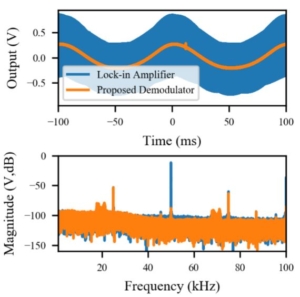 | S. I. Moore; M. G. Ruppert; D. M. Harcombe; A. J. Fleming; Y. K. Yong Design and Analysis of Low-Distortion Demodulators for Modulated Sensors Journal Article In: IEEE/ASME Transactions on Mechatronics, vol. 24, no. 4, pp. 1861-1870, 2019, ISSN: 10834435, (This work was supported by the Australian Research Council Discovery Project DP170101813). Abstract | Links | BibTeX | Tags: Demodulation, DP170101813, Multifrequency AFM, Nanopositioning, SPM @article{Moore2019,System-based demodulators in the form of a Kalman and Lyapunov filter have been demonstrated to significantly outperform traditional demodulators, such as the lock-in amplifier, in bandwidth sensitive applications, for example high-speed atomic force microscopy. Building on their closed loop architecture, this article describes a broader class of high-speed closed-loop demodulators. The generic structure provides greater flexibility to independently control the bandwidth and sensitivity to out-of-band frequencies. A linear time-invariant description is derived which allows the utilization of linear control theory to design the demodulator. Experimental results on a nanopositioner with capacitive sensors demonstrate the realization of arbitrary demodulator dynamics while achieving excellent noise rejection. |
| 2. | 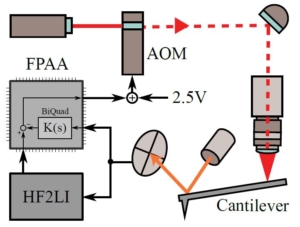 | M. G. Ruppert; B. S. Routley; A. J. Fleming; Y. K. Yong; G. E. Fantner Model-based Q Factor Control for Photothermally Excited Microcantilevers Proceedings Article In: Int. Conference on Manipulation, Automation and Robotics at Small Scales (MARSS), Helsinki, Finland, 2019, ISSN: 978-1-7281-0948-0, (This work was supported by the Australian Research Council Discovery Project DP170101813). Abstract | Links | BibTeX | Tags: AFM, DP170101813, Multifrequency AFM, Sensors, Smart Structures, SPM, Vibration Control @inproceedings{Ruppert2019,Photothermal excitation of the cantilever for dynamic atomic force microscopy (AFM) modes is an attractive actuation method as it provides clean cantilever actuation leading to well-defined frequency responses. Unlike conventional piezo-acoustic excitation of the cantilever, it allows for model-based quality (Q) factor control in order to increase the cantilever tracking bandwidth for tapping-mode AFM or to reduce resonant ringing for high-speed photothermal offresonance tapping (PORT) in ambient conditions. In this work, we present system identification, controller design and experimental results on controlling the Q factor of a photothermally driven cantilever. The work is expected to lay the groundwork for future implementations for high-speed PORT imaging in ambient conditions. |
| 1. |  | M. G. Ruppert; S. I. Moore; M. Zawierta; A. J. Fleming; G. Putrino; Y. K. Yong Multimodal atomic force microscopy with optimized higher eigenmode sensitivity using on-chip piezoelectric actuation and sensing Journal Article In: Nanotechnology, vol. 30, no. 8, pp. 085503, 2019, (This work was supported by the Australian Research Council Discovery Project DP170101813). Abstract | Links | BibTeX | Tags: AFM, Cantilever, DP170101813, MEMS, Multifrequency AFM, Piezoelectric Transducers and Drives, Sensors, Smart Structures, SPM @article{Ruppert2018b,Atomic force microscope (AFM) cantilevers with integrated actuation and sensing provide several distinct advantages over conventional cantilever instrumentation. These include clean frequency responses, the possibility of down-scaling and parallelization to cantilever arrays as well as the absence of optical interference. While cantilever microfabrication technology has continuously advanced over the years, the overall design has remained largely unchanged; a passive rectangular shaped cantilever design has been adopted as the industry wide standard. In this article, we demonstrate multimode AFM imaging on higher eigenmodes as well as bimodal AFM imaging with cantilevers using fully integrated piezoelectric actuation and sensing. The cantilever design maximizes the higher eigenmode deflection sensitivity by optimizing the transducer layout according to the strain mode shape. Without the need for feedthrough cancellation, the read-out method achieves close to zero actuator/sensor feedthrough and the sensitivity is sufficient to resolve the cantilever Brownian motion. |
2022 |
||
| 9. |  | In: Sensors and Actuators A: Physical, vol. 338, pp. 113496, 2022, ISSN: 0924-4247, (This work was supported by the Australian Research Council Discovery Project DP170101813). |
| 8. |  | Experimental Analysis of Tip Vibrations at Higher Eigenmodes of QPlus Sensors for Atomic Force Microscopy Journal Article In: Nanotechnology, vol. 33, iss. 18, pp. 185503, 2022, ISSN: 1361-6528, (This work was supported in part by the Australian Research Council Discovery Project DP170101813). |
2021 |
||
| 7. |  | Characterization of Active Microcantilevers Using Laser Doppler Vibrometry Book Chapter In: Vibration Engineering for a Sustainable Future , Chapter 45, Springer, 2021, ISBN: 978-3-030-48153-7, (This work was supported by the Australian Research Council Discovery Project DP170101813). |
| 6. |  | Active atomic force microscope cantilevers with integrated device layer piezoresistive sensors Journal Article In: Sensors & Actuators: A. Physical, vol. 319, pp. 112519, 2021, ISSN: 0924-4247, (This work was supported by the Australian Research Council Discovery Project DP170101813). |
2020 |
||
| 5. |  | Integrated force and displacement sensing in active microcantilevers for off-resonance tapping mode atomic force microscopy Proceedings Article In: International Conference on Manipulation, Automation and Robotics at Small Scales (MARSS), pp. 1-6, 2020, (This work was supported by the Australian Research Council Discovery Project DP170101813). |
| 4. |  | Amplitude Noise Spectrum of a Lock-in Amplifier: Application to Microcantilever Noise Measurements Journal Article In: Sensors and Actuators A: Physical, vol. 312, pp. 112092, 2020, (This work was supported by the Australian Research Council Discovery Project DP170101813). |
2019 |
||
| 3. |  | Design and Analysis of Low-Distortion Demodulators for Modulated Sensors Journal Article In: IEEE/ASME Transactions on Mechatronics, vol. 24, no. 4, pp. 1861-1870, 2019, ISSN: 10834435, (This work was supported by the Australian Research Council Discovery Project DP170101813). |
| 2. |  | Model-based Q Factor Control for Photothermally Excited Microcantilevers Proceedings Article In: Int. Conference on Manipulation, Automation and Robotics at Small Scales (MARSS), Helsinki, Finland, 2019, ISSN: 978-1-7281-0948-0, (This work was supported by the Australian Research Council Discovery Project DP170101813). |
| 1. |  | Multimodal atomic force microscopy with optimized higher eigenmode sensitivity using on-chip piezoelectric actuation and sensing Journal Article In: Nanotechnology, vol. 30, no. 8, pp. 085503, 2019, (This work was supported by the Australian Research Council Discovery Project DP170101813). |
